The Yosemite Naval Hospital was a learning experience for the military health system. Initially thought of as a quiet place to isolate recovering veterans, treatments at the Ahwahnee evolved to include social interaction and an understanding of the mind-body healing powers of one of America’s finest natural wonders.
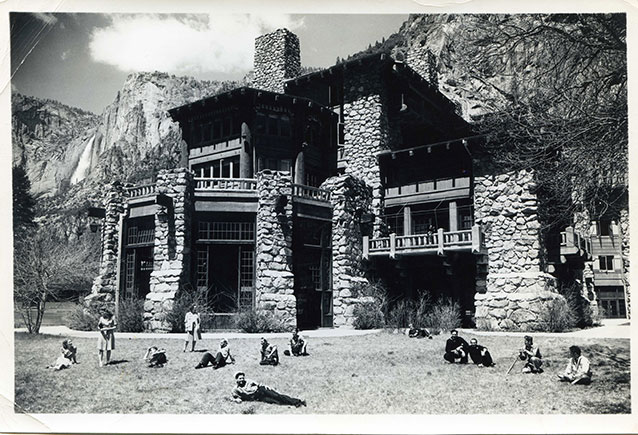
US Navy Bureau of Medicine and Surgery
Yosemite’s luxurious Ahwahnee Hotel was the brainchild of the National Park Service’s first director, Stephen Mather. Almost from the first moment he saw Yosemite Valley, Mather envisioned building a luxury resort hotel to attract the wealthier class of visitors and to set the standard of ‘Park-ictecture’ to be followed for generations.
On July 14, 1927, the Ahwahnee Hotel was formally opened to the public and managed by the Yosemite Park and Curry Company. The Ahwahnee did not prove to be initially as successful as expected. The Depression greatly reduced visitation to Yosemite, and its new luxury hotel operation was hit especially hard. As was true at national parks across the nation, when America entered World War II, subsequent fuel rationing and homefront mobilization efforts sent visitation spiraling downward. In 1941, over 500,000 visitors entered Yosemite; that number would drop to as low as 119,000 in 1944
The Navy Commissions The Ahwahnee
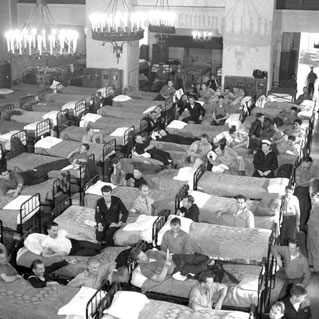
National Park Service
After the Japanese Attack on Pearl Harbor, Yosemite National Park joined national parks across the nation in efforts to join the war effort while preserving and protecting the park’s precious ecosystems. In 1943, well into the war, the Navy leased the Ahwahnee for a recuperation hospital, with the first staff arriving at the end of May to begin refitting. The transition was not easy, partly because visitors were still being lodged at the facility when the Navy arrived. The “U.S. Naval Convalescent Hospital Yosemite National Park, California” was commissioned on June 25, 1943. Eleven days later, the first patients arrived.
The Navy’s operation at Yosemite was initially intended for neuro-psychiatric rehabilitation. The thinking was that shell-shocked patients would respond well to the peaceful setting of an isolated scenic facility. In fact, the site quickly proved to be exactly the opposite of what these patients needed. The towering cliffs caused many to become claustrophobic. Isolation and lack of diversionary social or entertainment outlets left their disturbed idle minds preoccupied with the very memories the Navy hoped to erase. Within a few months, hospital administrators wisely decided to phase out psychiatric treatment at the Ahwahnee and convert the facility into a general physical rehab unit. It was a new direction, but the same old problems prevailed. As one early staff member recalled, “If the patients weren’t nuts when they got to Yosemite, the boredom there soon sent them over the edge.” Staff morale also suffered badly.
Healing Through Interaction, Not Isolation
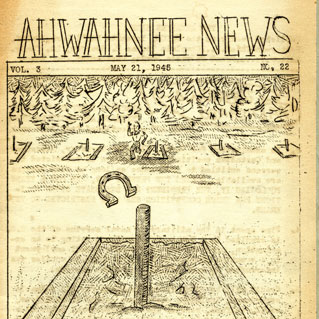
US Navy Bureau of Medicine and Surgery
A change in Navy leadership in August 1943 marked a dramatic change in the hospital’s rehabilitation strategies. The new commander, Capt. Reynolds Hayden, was a seasoned veteran with years of experience managing military medical units (including commanding officer of the Navy Hospital at Pearl Harbor during the 1941 surprise attack). Besides being an inspirational leader, Hayden was competent, sensible, compassionate, and very resourceful. He immediately began aggressively expanding the hospital’s recreational and rehabilitation resources.
A hospital newspaper The Ahwahnee News contributed to the development of morale. It was established in December 1943 was published monthly until the end of the war. It featured stories on staff and patients, humorous cartoons, and a run down of the immense number of activities that were now available to patients and staff. The National Park Service and a number of local and regional civic organizations also began to take a keen interest in improving the plight of the staff and patients stationed at Yosemite. By successfully scrounging, begging, borrowing, and politicking, Hayden’s administration expanded hospital facilities to include: a library, a six-lane bowling alley, an extensive crafts department, a pool hall, daily excursions to Badger Pass during the winter (with free equipment and mandatory lessons from a staff trainer), re-opening of the Camp Curry toboggan run (operated by Navy staff), educational classes, a Ship’s Service store (including a soda fountain), a Welfare Fund, machine and wood shops, and transportation facilities (and adjusting Navy regulations so patients and staff could take leave outside the park).
Family Visits and Outings Encouraged
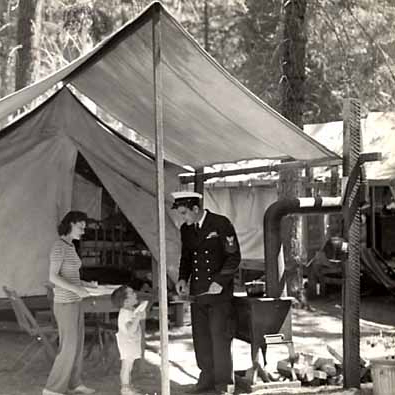
National Park Service
Family visits were encouraged and, by the end of the war, considered 'invaluable' to staff and patient morale. In the fall and winter of 44-45, 45 cabins from the Curry Company were made available to rent to patient and staff family members. By summer of 1945, 90 tents and 59 additional cabins were added.
Efforts were made to overcome the isolation of Yosemte National Park by setting up regular transportation to Merced, Fresno, or Oakland. Rangers provided ski instructions in the winter, though initial hospital reports did remark that 'one serious difficulty encountered was that a great many patients were 'surviviors' from sunken ships and had no suitable clothing for winter sports.' During the summer, swimming, fishing and guided hikes were popular along with horseback riding. A family visit and horsebackriding trip was featured in the 1945 film The Caine Mutiny. The film shows the lead character, a sailor, recouperating at the Yosemite Special Hospital and enjoying a day's activity with his fiance.
By wars end, the Hospital library, which started with about 1,400 books had grown to over 4,000. Movies were shown 5 nights a week. Additional hospital improvements included tripling the hospital’s physiotherapy facilities and equipment, significantly improving available housing for families of patients and staff, forming a staff/patient dance band at the hospital, organizing regular guest appearances by orchestras and USO entertainers, acquiring a projector and screen to show Hollywood movies on a regular basis, constructing new concrete tennis and basketball courts, and, last but not least, building the servicemen’s own “Oasis” beer joint, the only authorized pub in any Naval hospital around the world.
The Healing Power of Nature and Community
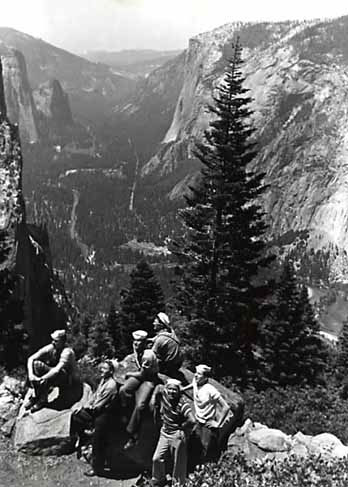
National Park Service
During the time the hospital was in commission 6,752 patients were admitted. Of these about 65% were returned to duty and the remainder discharged from the Service. The greatest number of patients at any one time was 853. While Navy men dominated the hospital’s patient list, soldiers, Marines, and Airmen also stayed at the hospital.
By the time the hospital was decommissioned in December 1945, rehabilitation at Yosemite’s newly renamed “Special” Hospital had dramatically changed from what the first patients experienced a year and a half earlier. Priorities for treatment shifted from simply warehousing and physically fixing up patients to a more holistic approach of healing them body and soul. Administrators realized that treatment needed to include mainstreaming patients back into a non-military social environment, rather than isolating them from it.
Because it was impossible to move the hospital to a “normal” community social setting, Capt. Reynolds decided to create a community at Yosemite for the patients and staff. All he had to do was provide the housing, recreational facilities, and activities; the social interaction they fostered would do the community-building for him. And, of course, success was due in a large part to the outlying communities bringing themselves to the hospital.
It was a remarkable, and truly “special,” learning experience for the hospital’s staff and administrators. The Yosemite Special Hospital experiment proved to be a watershed event in the development of U.S. military medical rehabilitation techniques.
In 2009, the Ahwahnee Hotel hosted a reunion of hospital staff and patients. They were treated to dinner, swing and ragtime music, and history presentations about their special time at Yosemite. Over 30 veterans attended.
Last updated: August 18, 2017
